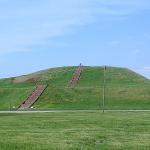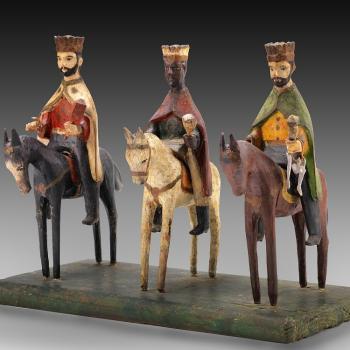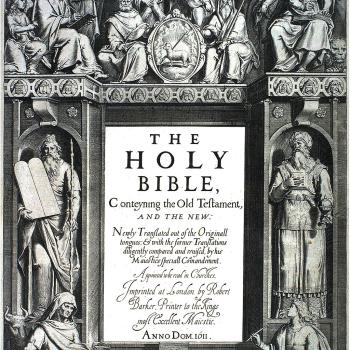I have several Bibles on my shelf—some in ancient languages, some translations that I use for devotion, and some for study. My reading is often paired with commentaries or devotional literature, but even when I am reading without additional sources, I am never reading the bare text. In fact, each Bible we have has extrabiblical material therein, what we might call paratextual devices, which change the way we read and engage with the Scriptures.
A paratextual device is an apparatus which “surround [the text] and extend it, precisely in order to present it” (Genette, Introduction to the Paratext, 261). For instance, a table of contents, titles, headings, prefaces, etc., might be considered a paratext (For a fuller discussion of these devices, see: Coogan, Eusebius the Evangelist, Ch. 2). The most obvious examples of this in our Bibles is chapter and verse numbers, along with thematic headers. These might seem innocuous, but they inevitably change how much Scripture we read in a sitting, what we memorize, and what passages are read together—something that the earliest readers of the text did not share. Modern scripture verse and chapters numbers were introduced in the 16th century, but this is certainly not the first time a paratextual device is placed in the Scriptures. One foundational source, which changed the way the Gospels were read for the rest of Christian history, can be traced back to Eusebius of Caesarea: the Canon Tables. This was such an influential apparatus, that an ancient Ethiopic Gospel manuscript includes 5 portraits at its outset to represent the evangelists—Matthew, Mark, Luke, John, and Eusebius.
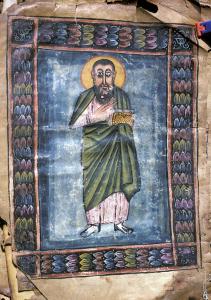
The Tables
Eusebius is a fourth century bishop, primarily renowned for his work as a church historian, but he was also a biblical scholar, theologian, philosopher, and apologist. His exegetical attention is portrayed most prominently in his Commentary on Isaiah and Commentary on the Psalms, but it is also seen in his innovative Bible study tools, such as the Onomasticon (catalogue of biblical places), Psalm Tables, and Canon Tables. The latter is his most influential tool, an inventive cross-referencing system which connects ‘similar’ passages across the Gospels. This apparatus is found in over 100 extant manuscripts from the 6th to the 16th century in Greek, Latin, Syriac, Gothic, Armenian, Georgian, Ethiopic, and Coptic (some of which you can access in the New Testament Virtual Manuscript Room).
The Canon Tables are composed of three essential components. 1) The Letter to Carpianus, the initial epistle which explains how to use the canons to find “those passages which say similar things” (Eusebius, Letter to Carpianus, 42-3). 2) The tables themselves, which are categorized into ten canons at the beginning of the Gospels, containing the paired sections. Each table has a unique set of material—Canon 1, for instance, has corresponding passages in Matthew, Mark, Luke, and John, while Canon IV has material from Matthew, Mark, and John.
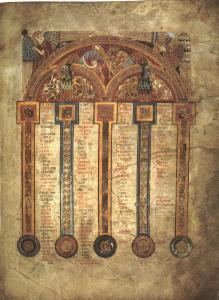
3) The Gospel manuscripts have marginalia alongside the text, containing numbered sections which mark the passage of the text and which canon it belongs to. When these three elements are used in conjunction, the reader can study and reference the corresponding material in the Gospels. If you really want to follow me down the rabbit hole, you can use the apparatus in E. Nestle and K. Aland’s Novum Testamentum Graece, 28th edition, which is freely accessible virtually.
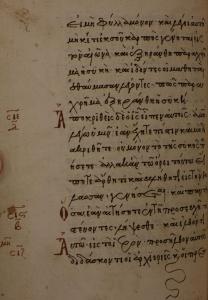
Theologically Neutral?
We are often unaware of the impact of paratextual devices on our reading, even assuming they are neutral in some way. After all, they do not change any of the words of the text or reorder them, as some of the earlier attempts to harmonize the Gospels, like Tatian’s Diatessaron. But, Eusebius’ Canon Tables challenge this assumption—they push us to read the Gospels in a certain way.
First, the Canon Tables encourage a reading which implies canonical unity. In the early church, the now canonical Gospels were largely seen as distinct books, which encouraged an individual narrative reading of each work. Eusebius’ Canon Tables, as a system itself, required a single Gospel ‘volume,’ where the four Gospels are bound together to function properly. In other words, to use the Canon Tables, the four individual Gospels must be bound together and used in conjunction. In this bound form, readers no longer consider the individual Gospels as distinct from the other; they are read as a unit. In this sense, the Canon Tables aided the identity shift of the four Gospels as distinct texts, to ones in close relationship to one another.
Second, the tables encourage a different type of reading across the Gospels. The most natural reading of a work is a linear one, but the Canon Tables allow for a non-narrative reading of the text where multiple corresponding passages can be read together. As Francis Watson notes, “One reads through the text, from the beginning toward the end, but one may also now read across the text, from one location to a second and perhaps also to a third and fourth” (Watson, The Fourfold Gospel, 123). By using the Tables, readers are encouraged to read and study the Gospels, not solely as distinct narrative accounts, but also as corresponding and united works.
Third, the Canon Tables invite particular theological readings of the text. The pairings, of course, are not discourses that fully explain Eusebius’ thought concerning these topics, but they do invite readers to think about important theological themes by pairing suggestive passages. Take, for example, the genealogies of Christ in Matthew 1 and Luke 3. In some ways, these are a natural pairing—and no surprise, Eusebius links them. But, he also pairs these passages with John 1:1, 1:9-10, 1:14, which have obvious literary differences. The Johannine passages discuss the divine origin of the Logos, while Matthew 1 and Luke 3 express the human birth and lineage of Jesus. In other words, the passages from Matthew, Luke, and John are distinct in narrative context and generic content—but they do share a common theological theme: the origins of Christ. Eusebius encourages readers to understand Christ as both of divine and human origin, a theological assumption that can be made when reading these verses together.
Dwelling on the Changes
If paratextual devices change our reading the text, we must dwell on these changes. In some instances, I would argue these devices have positive effects. Eusebius’ Canon Tables stimulate a theological and canonical reading of the Gospels. I find this a welcome suggestion! I have other Bibles with similar positive elements. My Ancient Faith Study Bible encourages me to read the text with those in the early tradition; my NIV Study Bible contextualizes my reading in the periods and places of the writers of the Scriptures. But, we might also be wary of what goes into the text, exemplified in Donald Trump’s recent partnership with Lee Greenwood on the God Bless the USA Bible. While there are a host of issues with this, one of which was recently discussed in a post by Lynneth Miller Renberg, I want to focus on one: how do the documents embedded in the text alter our reading?
Honestly, I do not own one of these Bibles nor intend to—but I do know from its advertising that the Bible includes historical American documents, such as the U.S. Constitution, Pledge of Allegiance, the Declaration of Independence, and the chorus from Greenwood’s own song, God Bless the USA. It is not difficult to imagine how we might read the Bible with these documents in place. For one, the Scriptures inevitably get tied up with American politics, rather than the world of the Scriptures. While politics have been impacted by the Bible (and vice versa) for centuries, this encourages a western and modern American understanding of the Word, rather than a historic or global one. While the inclusion of the U.S. Constitution does not change the words on the page, it does change how I read said words: the Constitution informs the Bible and vice versa. Evangelicals have long upheld the idea of Scripture alone (Sola Scriptura), that the Bible is the ultimate source of theology, the ‘norming norm’. But, we never truly read the Scriptures ‘alone’, exemplified by the inclusion of these US documents in the text. Others are guiding us in our approach to the text. Are we being critical enough about the assumptions drawn from paratextual sources that norm our reading of the Bible?
In all of this, it is important to note that I generally find paratextual devices to be helpful in my own reading of the Bible. But, we must not assume that they are neutral. In fact, they change how we read the Scriptures, for better or worse. While I may read the Bible without the words of other scholars explaining its meaning, these paratextual devices ensure that I never approach the text without their guiding voice through the titles, chapter and verse numbers, and cross-references placed therein.



